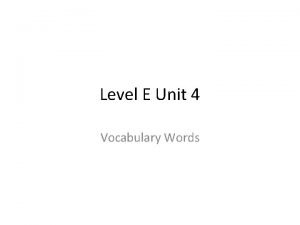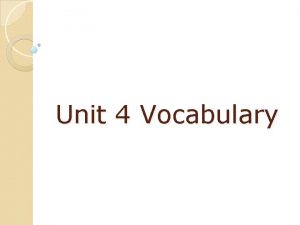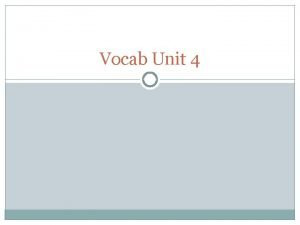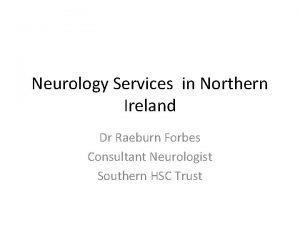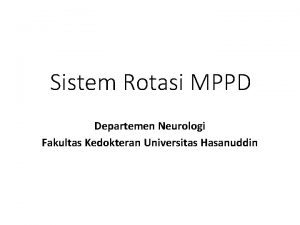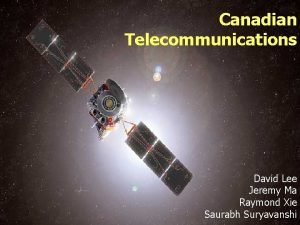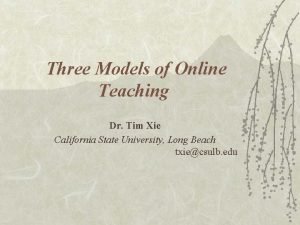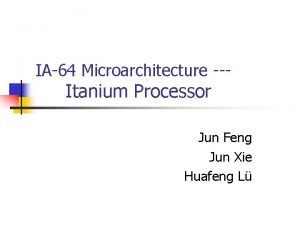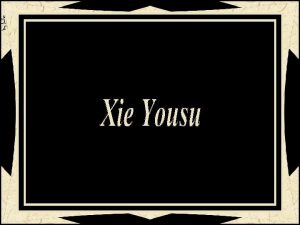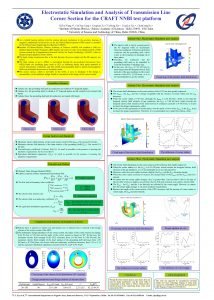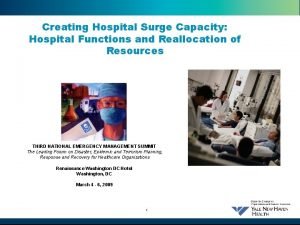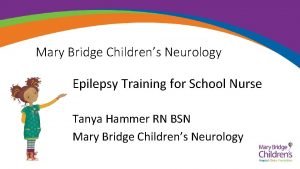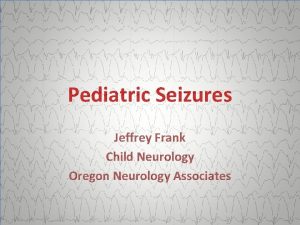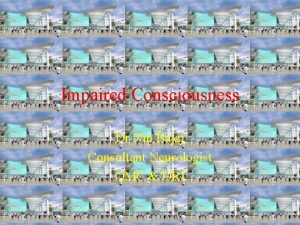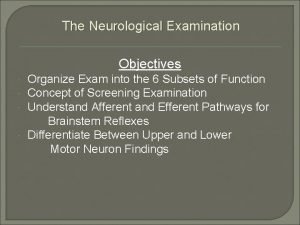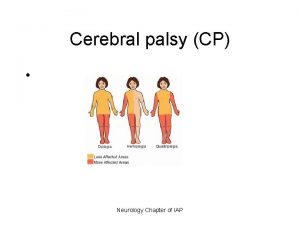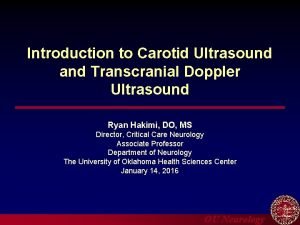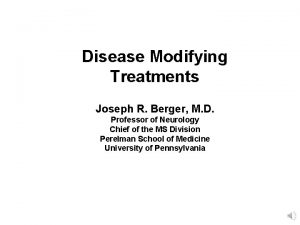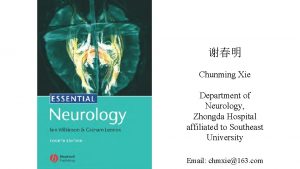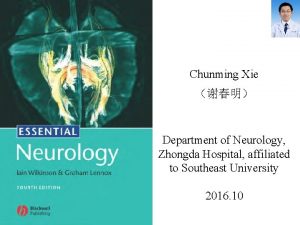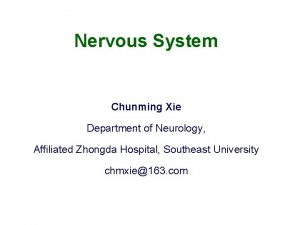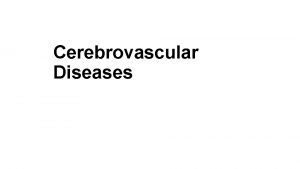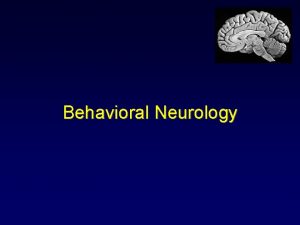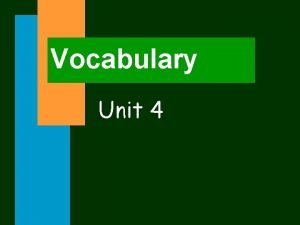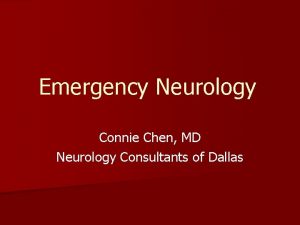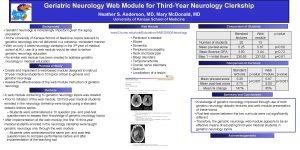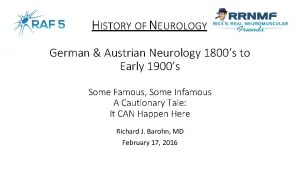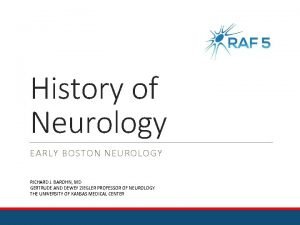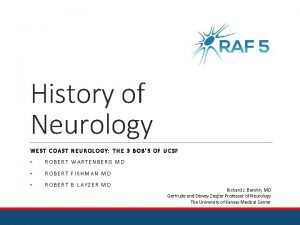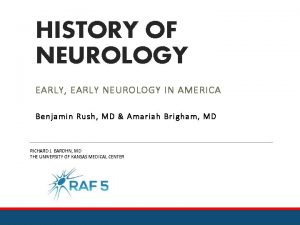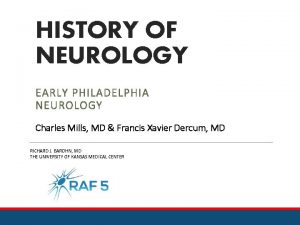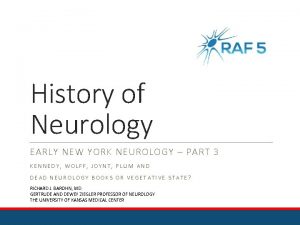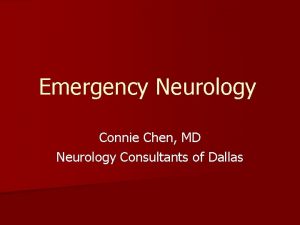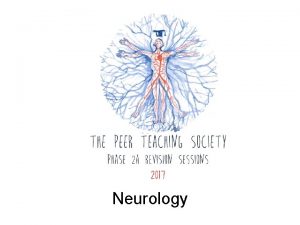Chunming Xie Department of Neurology Zhongda Hospital affiliated


































- Slides: 34

Chunming Xie (谢春明) Department of Neurology, Zhongda Hospital affiliated to Southeast University Nanjing, China

Features of various part lesion Leg monoplegia ØMotor cortex • Monoplegia: as motor cortex is spread over a large area, cortical lesion usually gives rise to monoplegia rather than hemiplegia Contralateral monoparalysis

Features of various part lesion ØCerebral Cortex • Aphasia or dysphasia: if the lesion is in the frontal lobe, esp in inferior frontal gyrus, aphasia is present. • Grasp reflex is present and the patient is emotionally labile(unstable). • Other manifestations like apraxia or agnosia may be present. • Specific manifestations due to lesions of various lobes such as • inferior quadrantanopia • homonymous hemianopia

Features of various part lesion ØInternal capsule • uncrossed hemiplegia: such as left hemiplegia plus left facial palsy. • hemisensory loss • homonymous hemianopia

Features of various part lesion ØBrain stem • Crossed hemiplegia: cranial nerve palsy is on one side and hemiplegia is on the other side. • Motor cranial nuclei control the ipsilateral cranial muscles, for example, left facial nerve controls left facial muscles. • While the pyramidal tract in unilateral brainstem crossed through pyramid in medulla oblongata to opposite side of spinal cord. • Lesion is on the side of cranial nerve palsy.

Features of various part lesion ØBrain stem • Further localization depends on cranial nerve involvement lesion. • 3 rd nerve ——midbrain • 7 th nerve——pons • 9 th, 10 th or 12 th nerve—— medulla oblongata

Features of various part lesion ØSpinal cord • If spinal lesion is unilateral, the lesion is on the side of motor weakness. • Hemisection of spinal cord (Brown-Sequard syndrome): below the level of the lesion there is: • ipsilateral UMN weakness and loss of sense of position • contralateral loss of sense of pain and temperature • UMNL is usually bilateral. A transverse spinal lesion causes quadriplegia or paraplegia. Complete transection Hemisection Brown-Sequard B-S-S Paraplegia

monoplegia hemiplegia Crossed hemiplegia quadriplegia paraplegia Paralysis subtypes of lesion in pyramidal tract

Features of LMN lesion ØNuclei of cranial nerves: the damage of the motor nuclei of the brainstem. • If nuclei of cranial nerves are involved, there is paralysis of muscles supplied by the affected nerves. • Manifestations are similar if cranial nerves themselves are involved along their course. • Incomplete damage of oculomotor nerve is a special feature, because oculomotor nucleus is scattered and spread in the brainstem.

Features of LMN lesion ØAnterior horn cells: • Poliomyelitis: seen in childhood • Motor neuron disease: manifestations are widespread, such as paraparesis or quadriparesis with twitching. ØNerve root: • If a root is involved, the muscles supplied by that root are paralyzed. • For example, if C 7 or C 8 root is damaged, there is paralysis of the small muscles of the hand.

Features of LMN lesion ØPeripheral nerves • If peripheral nerves are involved, muscles of distal parts of the limbs are affected. • In Guillain-Barre syndrome, there is quadriplegia.

Cerebellar dysfunction ØSigns: ataxia, hypotonia, nystagmus, dysarthria ØAtaxia refers to impaired coordination. • Cerebellar hemisphere lesion affects the limbs on the same side. • finger-to-nose test • heel-knee-shin test • With midline lesion of cerebellum, there is marked trunk ataxia, especially on walking. • Romberg test

Extrapyramidal disorder • Abnormalities are mainly as follows: • Tremor: It is a steady rhythmic oscillatory movement of the muscles. • Chorea: rapid, irregular, jerky movements • Dystonia: It refers to involuntary and prolonged muscular contraction that give rise to repetitive twisting or abnormal postures. • Myoclonus: sudden rapid twitch like muscle contraction

Reflex • The basis of reaction is reflex arc, which consists of a receptor, afferent fiber, spinal center, efferent fiber and effector organ. • Whole reflex arc should be intact for the reflex to be elicited.

Physiological Reflex • Tendon reflexes (deep reflexes or tendon jerks) • Common tendon reflexes • biceps jerk(C 5 -6), triceps jerk(C 6 -7), brachioradialis jerk(C 5 -6) • knee jerk(L 2 -4), ankle jerk(S 1 -2) • Tendon reflexes may be normal, increased or diminished. • Increased tendon jerks (hyperreflexia): they are the sign of upper motor neuron lesion (UMNL), especially it is present in one limb or one half of the body. • Diminished tendon jerks (areflexia): reflexes are diminished or absent in lower motor neuron lesion (LMNL). a- motor neuro n g-motor neuron Muscle spindle Striate muscle

Physiological Reflex Pathological signs • Superficial reflexes • Pathological signs: • Common superficial reflexes • corneal reflex, abdominal reflex(T 8 -12), cremasteric reflex(L 1 -2), anal reflex(S 3 -4) • Superficial reflex loss occurs with UMNL and LMNL. • Babinski sign is an abnormal reflex. It indicates the lesion of UMN including motor cortex and corticospinal tract. • Others: • Chaddock sign • Oppenheim sign • Gordon sign

Sensory System 1 Anatomy and Physiology 2 Sensory symptoms 3 Localization of lesion

1 Anatomy and physiology • Primary sensations: They are pain, temperature, touch, vibration, joint position sense. Primary sensations are divided into 2 types based on sensory receptor: • Superficial senses: sensory receptors in skin and mediating superficial sensation, including pain and temperature and portion of touch • Deep senses: joint position sense, sense of passive movement, and vibration • Cortical sensations: • • Sense of localization, Two point discrimination, Stereognosis, Graphesthesia.

1 Anatomy and physiology • Sensory stimuli are perceived by sensory receptors and transmitted to the dorsal root ganglions through peripheral sensory nerves. • Central axons of dorsal root ganglions enter the spinal cord where fibers are divided into two groups. • Dorsal Column • Lateral Spinothalamic Tract

Dorsal Column • Deep sensory pathways • fibers concerned with deep sensation enter the posterior part of the spinal cord, namely dorsal column, and ascend upwards on the same side. • They relay in the gracile and cuneate nuclei. • The fibers from those 2 nuclei cross to the opposite side and pass upwards to thalamus and at last to sensory cortex. • dorsal root ganglion——dorsal column——gracile, cuneate nuclei——sensory decussation——thalamus——sensory cortex • Deep sensation • • position Vibration passive movement touch

Lateral Spinothalamic Tract • Superficial sensation • Pain • Temperature • Superficial sensory pathways • dorsal root ganglion——dorsal horn—— crossing to lateral spinothalamic tract—— thalamus——sensory cortex • In the brainstem, the spinothalamic fibers are joined by the fibers of the trigeminal nerve.

Sensory Cortex • Sensory cortex occupies the post central gyrus. • Just like motor cortex, sensory cortex is a deformed homunculus.

Dermatomes and cutaneous nerves C 2, C 3 occipital and neck C 4 shoulder C 5—T 2 arm T 4 breast T 6 xiphoid T 10 umbilicus T 12 inguen L 1—S 2 leg S 1, S 2 foot S 3—S 5 perianal region

Sensory Symptoms • Positive phenomena: abnormal sensations such as • • • tingling pins-and needles pricking burning electric current like sensations or pain • Negative phenomena • does not appreciate normal sensations like touch, pain or temperature.

peripheral nerves sensory root spinal cord Localization of lesion various kinds of sensory loss are associated with the localization of lesion spinal cord brain stem internal capsule hysteria

Peripheral nerves • If there is peripheral neuropathy, the sensory loss is over the distal parts of limbs-in glove and stocking distribution. Sensory root • Sensory loss is in the distribution of the affected nerve root.

Spinal cord • When spinal cord is injured, bilateral spinothalamic tracts and dorsal columns are involved • So, there is loss of all senses below the level of the lesion: • • • pain temperature vibration joint position touch

Spinal cord • When unilateral spinothalamic tract is involved, there is loss of pain and temperature below the level of the lesion on the opposite side of the body. • If one side of posterior column is involved, there is loss of sense of position and vibration below the level of the lesion on the same side.

Spinal cord • Dissociated anesthesia: some modalities are affected while others are intact. Usually pain and temperature are lost, and touch, position and vibration are intact. • This occurs in syringomyelia.

Brain stem • Crossed anesthesia: the loss of pain and temperature on the same side of the face and the opposite side of the body.

Thalamus • In lesion of the thalamus • Contralateral touch is lost • Unpleasant pain on the contralateral side • Threshold of the pain is increased, but it is severe when it occurs.

Internal capsule • Hemianesthesia: • such as sense loss of left face, left arm and left leg • Accompanied by • hemiplegia • homonymous hemianopia

Sensory cortex • Lose of cortical sensations • • localization two point discrimination stereognosis Graphesthesia • Touch, pain and temperature are intact. • monoplegia is common.

Questions: • Difference of the UMN and LMN? • The definition of dissociated anesthesia. • Describe the features of damaged motor system and sensory system briefly.
 Level e unit 4
Level e unit 4 Affiliated ascertain attainment
Affiliated ascertain attainment Vocab unit 4 level e
Vocab unit 4 level e Dr raeburn
Dr raeburn Department of neurology
Department of neurology Raymond xie
Raymond xie Xie bellringer
Xie bellringer Shangping xie
Shangping xie Tim xie
Tim xie Elizabeth xie
Elizabeth xie Intel itanium
Intel itanium Pengtao xie
Pengtao xie Alibaba leadership style
Alibaba leadership style Xie yousu
Xie yousu Corner simulation
Corner simulation Hen duo xie
Hen duo xie Zachary ho
Zachary ho Tian shang tian xia wei wo du zun
Tian shang tian xia wei wo du zun Convection threshold
Convection threshold Objectives of hospital pharmacy
Objectives of hospital pharmacy Functions of laundry department in hospital
Functions of laundry department in hospital Organizational structure of hospital pharmacy
Organizational structure of hospital pharmacy Flagler hospital billing department
Flagler hospital billing department Internal medicine shelf exam percentiles
Internal medicine shelf exam percentiles Mary bridge pediatric neurology
Mary bridge pediatric neurology Oregon neurology associates
Oregon neurology associates Qmc neurology
Qmc neurology Motor strength scale
Motor strength scale Cerebral palsy iap
Cerebral palsy iap Umass memorial pharmacy residency
Umass memorial pharmacy residency Nlff neurology
Nlff neurology Neurology sonography
Neurology sonography Uf neurology residents
Uf neurology residents Neurology near loomis
Neurology near loomis Joseph berger md neurology
Joseph berger md neurology
